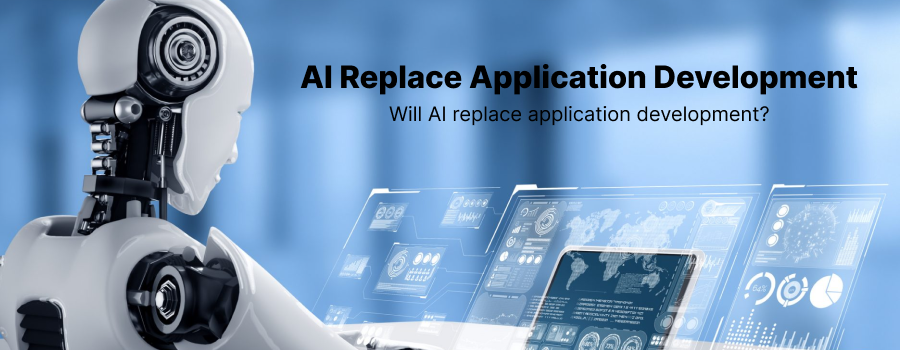Posted on: Jul 31, 2024
Estimated reading time: 0 minutes
Will AI replace application development?

Can AI eliminate the necessity for human developers in the future, or will it instead serve as a valuable partner in the coding journey?
Evolving AI in Application/Software Developer:
AI is already getting space in many fields, but in tech ( Information Technology ) makes a wider change and concern to think about.
As for many of the aspects we can say, that AI can do it in minimum time, like
Automation of repetition tasks:
AI can automate many repetitive and time-consuming tasks, such as code generation, bug fixing, and testing. Tools like GitHub Copilot, TabNine and various code auto-completion services are examples. Also before automation, these tools leverage machine learning models that have been trained on extensive code datasets to offer developers smart code suggestions, greatly accelerating the coding process.
By taking care of routine and repetitive tasks, AI enables developers to concentrate more on the creative and strategic elements of their projects.
By using machine learning models trained on large code datasets, these tools provide developers with intelligent code recommendations, significantly speeding up the coding process.
Rapid Prototyping:
Developers can concentrate on more intricate and creative parts of the project by using AI to help with the rapid generation of prototypes and boilerplate code. Artificial intelligence (AI)-driven prototyping tools can analyze project requirements and generate working prototypes far more quickly than manual techniques.
This speeds up the development process and also assists in catching potential issues early on in the development cycle.
Testing and quality assurance:
AI-driven technologies that automatically create test cases, find bugs and recommend fixes can improve testing procedures. Higher code quality and a lower chance of bugs making it into production are ensured by these tools' capacity to conduct extensive testing that may be beyond the scope of human testing.
AI can also analyze past bugs and predict areas in the code that are likely to cause issues, allowing developers to preemptively address potential problems.
If this has benefits, so does the limitation.
Limitations:
Creativity and Innovation:
Developing applications frequently involves using creative problem-solving and innovative thinking, which are strengths of human developers but weaknesses of AI.
Although AI can help with coding and proposing enhancements, it struggles to think creatively and devise original solutions for distinct challenges.
Creativity plays a crucial role in crafting user interfaces, creating distinctive functionalities, and addressing intricate problems that demand a thorough grasp of the issue at hand.
Complex Problem Solving:
A lot of development work entails solving intricate problems that call for contextual knowledge and in-depth comprehension, both of which AI is currently unable to fully replicate.
Managing unclear requirements, weighing trade-offs, and making decisions based on a sophisticated grasp of the project's objectives and constraints are all common challenges in the development of robust software solutions.
“Dealing with ambiguous requirements, evaluating compromises, and deciding with a deep understanding of the project's goals and limitations are typical hurdles in creating reliable software solutions.“
Customization and Adaptation:
Creating customized solutions that satisfy particular business requirements necessitates a degree of adaptability and customization that AI cannot provide without substantial human involvement.
Every application comes with its own set of specific requirements and limitations that demand tailored solutions.
People who create software are skilled at understanding these unique requirements and modifying their techniques as needed, whereas artificial intelligence programs typically operate using the information they were trained on and the set of rules they have been programmed with.
Maintenance and Update Issue:
AI models may lose accuracy as they are exposed to new data, necessitating frequent updates and retraining sessions. Keeping AI systems up-to-date demands specific skills and know-how, creating a potential obstacle.
What’s the solution and future?
Collaboration between AI and Developers:
First of all, not everything depends on AI; it needs collaboration because, as we say in the limitation, every application has different requirements in UI, function, code, or else.
Embrace the power of AI-driven tools and techniques to boost productivity and foster innovation.
With AI handling routine tasks like code suggestions, debugging, and test case generation, developers can dedicate their time to tackling intricate and imaginative challenges in their projects.
By working together, we can speed up the development process, guarantee top-notch quality, and enhance security measures for our applications. This will result in stronger, more user-friendly solutions overall.
Through collaboration, there are many benefits developers can focus on higher-level tasks, and it also evolves job roles and many more.
Conclusion:
The landscape of application development is being revolutionized by AI, which streamlines repetitive tasks and boosts productivity.
However, it is important to recognize that AI will not completely take over the role of human developers.
“AI won't replace developers, but it will change the nature of development. The future is about humans and AI working together to create more intelligent software.“By Satya Nadella (CEO of Microsoft)